Welcome to the landscape photography blog by Chuck Derus. Thanks for looking and for your comments!
Contest
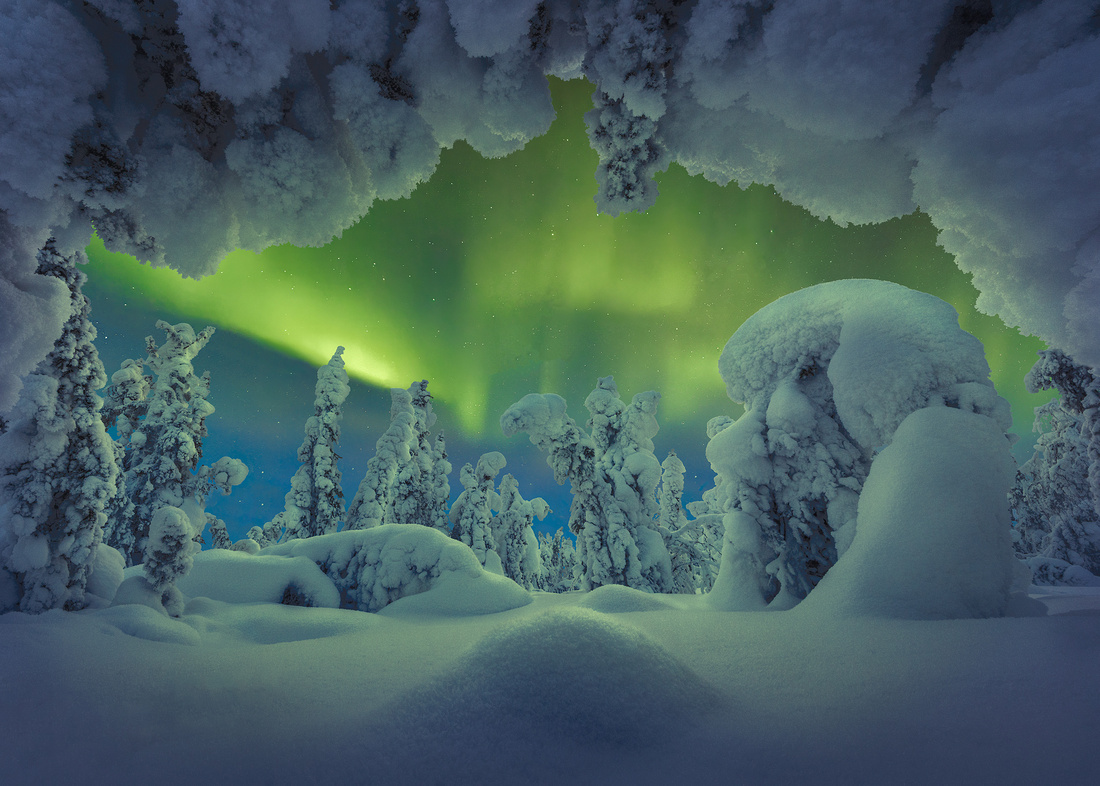

Photography is my hobby. It’s fun creating memories of the magnificent places and spectacular sights that I encounter. Also, I appreciate the challenge of learning and improving my skills. And I enjoy sharing images with folks that warm to my images and stories.
Winning awards is never my objective. Besides, professional photographers are just so much better at creating knockout landscape images.
Photographers like Gary Hart, Don Smith, Ian Plant, Marc Adamus, and Mark Metternich are in another league. Check out their websites if you are interested in what “good” truly looks like.
One of the two camera clubs I belong to includes competitions. Again, my primary reason for entering images is to share my work. In addition, a thoughtful critique is very much appreciated.
A month ago, I was invited by another local camera club to share lessons learned from 18 years of landscape photography. One of the questions afterwards was “Landscape photographs rarely win our camera club competitions because judges are drawn to birds and animals. Don’t you get discouraged when you rarely win?”
Not if you’re taking photographs for your own enjoyment!
The Contest
I usually delete emails about photo contests. But a few months ago, Ian Plant was promoting a Best of 2024 photo contest on his site.
Ian, along with the other four photographers referenced above, is one of the professionals that made an early impression on me. Ten years ago, I attended his Patagonia workshop and absorbed much photographic wisdom.
So, instead of deleting the email, I went through my best images of 2024 and submitted a couple of them. To my surprise, my image of the Northern Lights titled “Friday Night Lights” took second place!
If you’re interested, the announcement page is at Best of 2024 Contest Winners There’s a link on the page to a video where Ian and Taya Iv discuss the images and offer insights regarding their appeal and possible improvements. If you want to skip ahead to my image, it’s at 29:15.
The Shot
Readers with sharp memories will recognize this image from my January 10, 2024, Friday Photo. Wintertime blankets chaotic and distracting foreground details with beautifully simplistic snow. This makes the photographer’s goal of moving the viewer’s eye through the scene much easier.
The rime ice-covered trees bent towards each other creating a wonderful frame for the background leading the eye through the image. And the small mound of snow in the foreground was an unexpected bonus.
The image is a composite of a pre-dawn image of the foreground and an early evening image of the Northern Lights. Both were taken near Coldfoot, Alaska last February.
Thanks for looking,
Chuck Derus
Showing Up
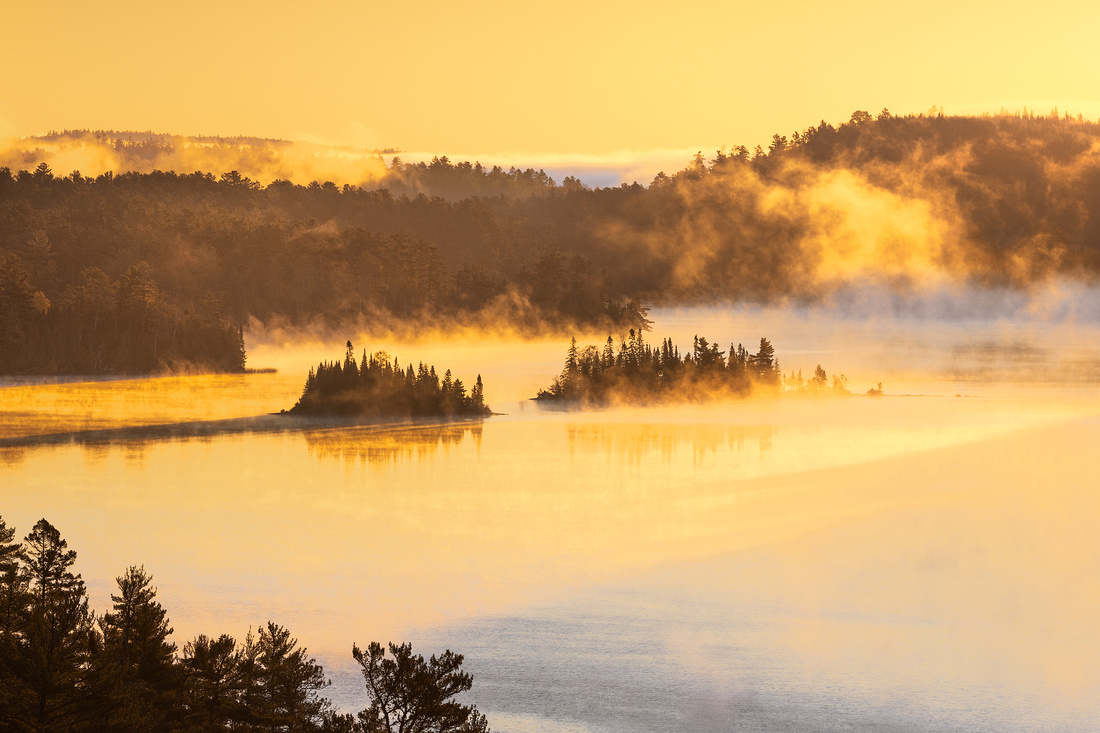

Showing up is 99% of the work. Photographer Bryan Hansel likes to say, “If you don’t show up, you’ll never take the photo.”
As my wife will attest, I’m not a morning person. But landscape photography demands rising early, driving to a location, and then hiking to be in position at least 45 minutes before sunrise when good light can begin to happen.
Sunsets are easier. Since good light can appear as late as 45 minutes past sunset, you need to stick around. Then you have to hike out and drive back to the hotel, where you set your alarm for an early wake-up call to repeat the process.
In the winter, long nights offer more hours for sleep between dawn and dusk. But in the summer, sleep is at a premium. After a few nights of sleeping only five hours, showing up requires commitment.
When you head out, you never know if it’s going to be worth the effort. While weather forecasts are increasingly accurate, the only way to know for sure is to show up.
The Caribou Rock Trailhead
This trailhead is located 23 miles north of Grand Marais, Minnesota. It takes about 20 minutes to hike this moderately uphill trail from the parking lot to West Bearskin Lake Overlook. Since the Overlook faces northeast, this is a sunrise photo opportunity.
West Bearskin Lake is located almost at the Canadian border in Minnesota’s Arrowhead region.
The Shot
The weather forecast didn’t look promising on the morning of October 4. “Severely clear” boring blue skies were predicted. But showing up is the work of photography.
So, our intrepid group of photographers rolled out of the sack at oh-dark-hundred to drive north. After an interesting hike in the dark guided by flashlight, we arrived at the overlook 45 minutes before sunrise.
At first, it appeared to be a bust. There were patches of fog, but the light and sky were anything but photogenic.
Suddenly, golden light bathed the landscape as the sun broke the horizon. For a few minutes, the sunlight danced with the fog creating a magical scene.
My go-to-lens is usually a wide-angle to capture an entire scene. This morning, two tiny islands over a mile away caught my attention. I switched to my telephoto lens and made them my subjects.
After the good light faded, we packed our gear and started down the trail to the parking lot. Along the way we met quite a few hikers asking about the view. While it was still pretty, it didn’t hold a candle to the gorgeous light we had witnessed earlier.
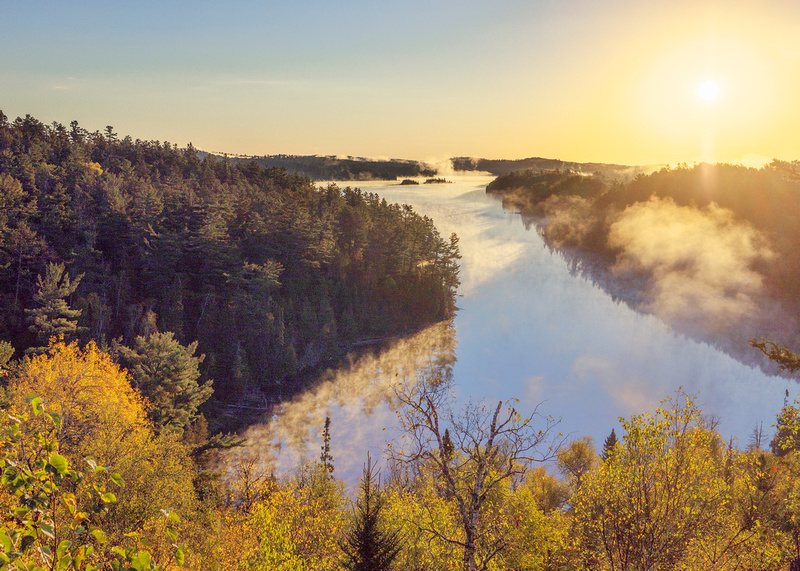

A wide-angle view as we left. Note the two tiny islands in the distance that are the subjects of my telephoto shot
Thanks for looking,
Chuck Derus
Lucky Strike
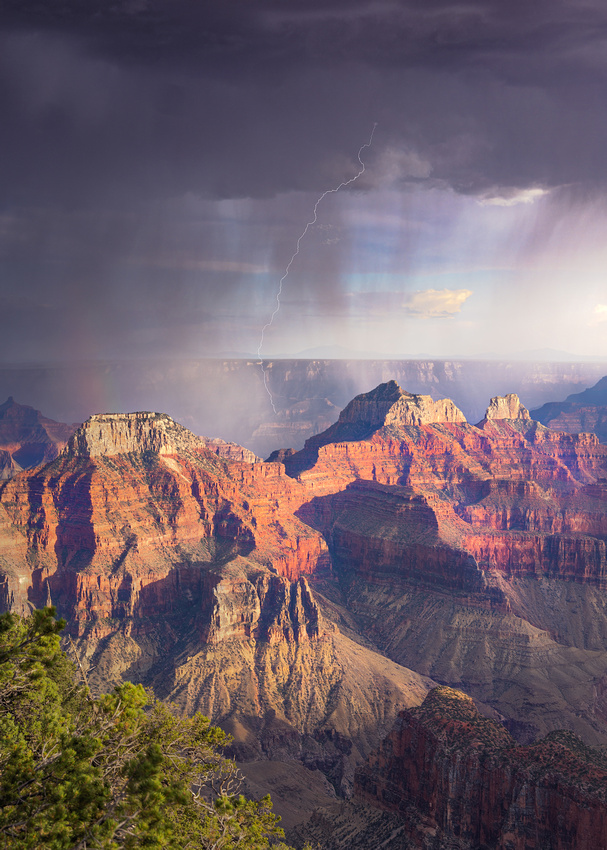

Extra ordinary means very ordinary. But extraordinary is defined as extremely unusual or remarkable.
As photographers, we aim to transform the ordinary into extraordinary. We might employ composition, perspective, lighting, emotion, abstraction, tone, and post-processing to create a compelling image.
You probably envision the Grand Canyon as extraordinary. And it is to the eye.
To the camera, it usually comes across as a dark hole in the ground. It works well for selfies and for “tourist” photos. But if you’re trying to create a compelling landscape image, it’s an extremely difficult location.
The Shot
The extraordinary qualities of storm light came to my rescue two summers ago on a trip to the Grand Canyon. Just as our group pulled into the parking lot of the North Rim Lodge, a monsoon storm appeared.
Forgetting about registration, we raced to the overlook and set up our cameras. A lightning trigger attached to the camera allowed us to capture a bolt much faster than we could possibly react and manually press the shutter button.
Most of the bolts were unremarkable or half in or half out of the frame. But this frame captured a bolt beyond the Zoroaster Temple formation in the distance. And there’s just a hint of a rainbow on the left.
It was a lucky strike that helped bring a bit of extraordinary into this image.
I’ll be on the road next week, so the next Friday Photo is March 21.
Thanks for looking,
Chuck Derus
The Karakoram Range
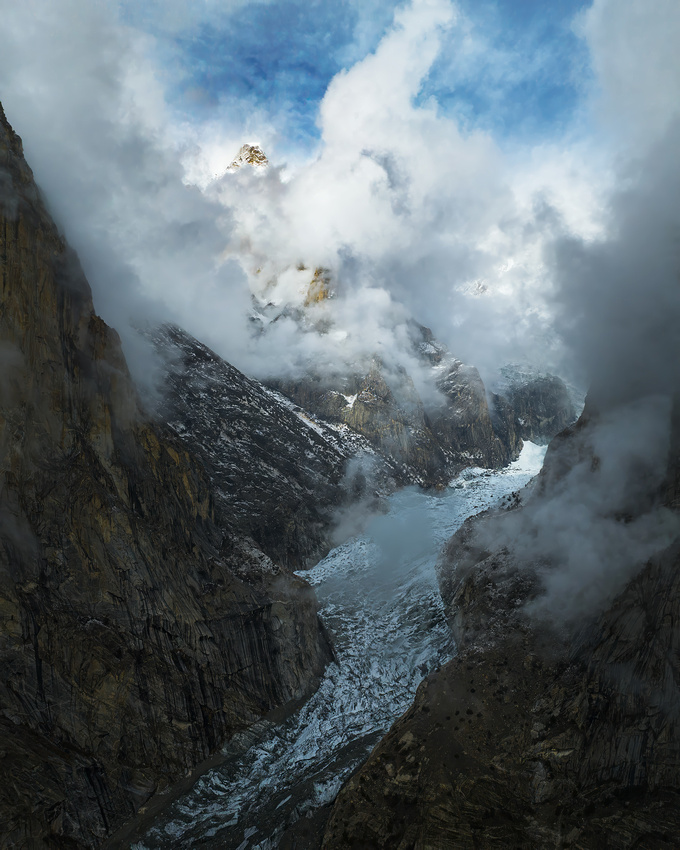

How long is a meter? It’s one ten-millionth of the distance between the equator and the North Pole.
Eight thousand meters may seem like an arbitrary number. But that number looms large for mountain climbers.
Only 14 mountain peaks on Earth stand taller than 8,000 meters (26,247 feet). And all 14 are found in the Karakoram and Himalayan Mountain Ranges of Central Asia.
The Karakoram boasts the greatest concentration of high mountains in the entire world and the longest glaciers outside of the high latitudes. This monstrous mighty mountain system extends 300 miles along the watershed between Central and South Asia.
The borders of Tajikistan, China, Pakistan, Afghanistan, and India all converge within the Karakoram Range. It’s pronounced “Kurra-koorrum,” a rendering of the Turkic term for “Black Rock” or “Black Mountain.”


Source: Brittanica
Ultar Sar
The Karakoram Range is a photographer’s dream. It’s the youngest, steepest, and most rugged mountain range on the planet. And there are glaciers galore.
Ultar Sar isn’t one of the highest peaks of the Karakoram. But it dramatically rises 17,388 feet above the Hunza River in only about 5.6 miles of horizontal distance.
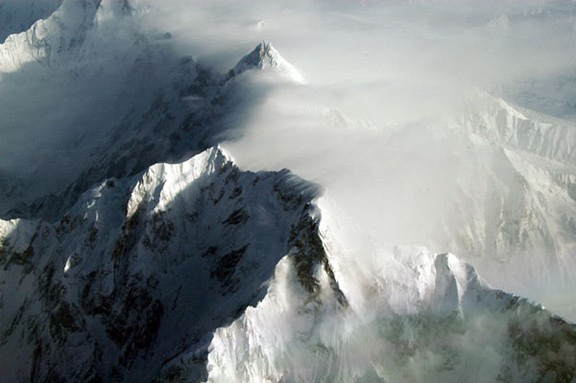

By Brian McMorrow https://commons.wikimedia.org/w/index.php?curid=768980
In this photograph by Brian McMorrow, Ultar Sar is in the center foreground viewed from the southeast. Shispare is in the center background.
Five glaciers drain the slopes of the massif. They are (clockwise from north): the Ghulkin Glacier, the Gulmit Glacier, the Ahmad Abad Glacier, the Ultar Glacier, and the Hasanabad Glacier.
The Shot
On November 10, 2023, I was with friend Jon Christofersen and our photo group near the town of Ahmad Abad. I launched my drone and flew north up the valley towards the glacier and mountains.


After flying about 6,000 feet north into the valley and climbing 2,600 feet, I arrived at the location marked 25 on the map. It offered a potentially glorious view of the Ahmed Abad Glacier in the foreground with Ultar Sar (about 5 miles away) and possibly Shispare in the distance (about 9 miles away).
But the roiling clouds didn’t cooperate. I held station with my drone for 30 minutes. Only one image showed the Ahmad Abad Glacier and probably Shispare in the distance. Ultar Sar never broke out of the clouds.
Disappointed, I downloaded the images after my trip and never processed them. But I enjoy looking through old “rejects” trying to find and salvage a keeper.
This reject appeared promising. While it didn’t feature both mountains, the combination of the Ahmad Abad Glacier valley with just the peak of Shispare breaking through the clouds in the distance made me happy.
Thanks for looking,
Chuck Derus
A Burger and Cones, Please


It’s the second highest paved road in the world. The Pakistani name N-35 doesn’t do it justice. Most call it the Karakoram Highway. And some have dubbed it the Eighth Wonder of the World because of its high altitude and construction difficulties.
This marvel of modern engineering extends 810 grueling miles. The 551 miles in Pakistan begin in the Punjab province of Pakistan. Along the way, it passes through the Karakoram Mountains. The final 257 miles are in China, beginning at the summit of the 15,466-foot-high Khunjerab Pass on the Pakistani/Chinese border.
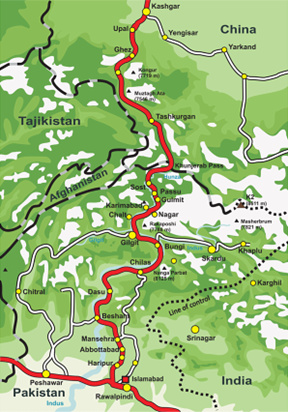

From Wikipedia
The Cones
The village of Passu is a renowned tourist destination along the Karakoram Highway. It’s situated in the Gojal valley of Upper Hunza in Northern Pakistan, not far from the Chinese border. I was there in November of 2023 with a photography group.


Passu is celebrated for its landscapes and breathtaking views of the 24,534-foot Passu Sar Mountain and the Passu Glacier. But the most photogenic peak in the region is the 20,033-foot Passu Cathedral, also known as the Passu Cones.
A Burger
After a week of mouth-watering curry dishes, our group was looking for some variety. Lo and behold, our guide had just the spot.


Passu is home to this culinary wonder. If you want to check it out further, the Yak Grill has a Facebook page at (2) yak grill passu - Search Results | Facebook. The menu seemed vaguely familiar, despite being 7,000 miles away from home.


I ordered the Burger of The House and thoroughly enjoyed my meal. It’s the tastiest, juiciest yak burger on a homemade bun I’ve ever had! And the fries are good as well. If you plan on going, $1 US equals around 279 Pakistan Rupees.


The Shot
Our group spent a day photographing around Passu. On a whim, I wandered across the highway from our hotel for an unobstructed view of the Passu Cones. As the snow and clouds swirled around the summit, myriads of pointy peaks appeared and disappeared. Atmosphere!
This image was my best out of numerous attempts that wonderful morning.
Thanks for looking,
Chuck Derus